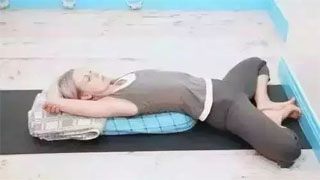
Do you like to sleep with your hands raised above your head?
Many netizens expressed that
This position is super comfortable to sleep in
I feel very relieved
And it's easier to fall asleep this way!
Is this sleeping position really beneficial to health?
What causes liking this sleeping position?
Actually, adopting this sleeping position will make the body feel very comfortable, but it is not recommended to maintain it for a long time. Why?
In the lying down state, if both arms are constantly extended above the head, due to muscle tension, the diaphragm will shift, causing the ribs to be out of position. At the same time, prolonged muscle tension will prevent the intercostal muscles, diaphragm, abdominal wall muscles, and chest muscles from returning to their original positions.
It is easy to cause chest tightness, and you will find that the muscles around your armpits are particularly sore when you wake up the next day, making it difficult to sleep. This is the first harm!
Another harm of sleeping with both hands raised above the head for a long time can also cause tension in the shoulder and back muscles, which cannot be relaxed. Over time, it can lead to shoulder and neck pain, numbness in the arms, and other problems, affecting breathing and shoulder and neck health!
What causes you to like this sleeping position?
This is mostly related to your physical problems (including hunchback, collarbone related muscle groups, shoulder and back tension), emotional problems (long-term emotional anxiety and tension), and incorrect breathing patterns (incorrect shoulder and neck breathing patterns)!
So why not practice this yoga sequence that opens the chest and relieves tension in the shoulder and back muscles more often? After practicing, you will find that even if your hands are not raised above your head, you can still sleep well!
Relax the muscle group around the pectoralis minor muscle first every day, and then practice this sequence.
Place the fascia ball or tennis ball in the position of the pectoralis minor muscle
Pressing the fascial ball against the wall or lying prone is also possible
Press and relax in four directions, left, right, up, and down, for 60 seconds each
Style 01, Lower Dog Style
Enter the Dog Style
Stay for 5-8 breaths
Style 02, Single Leg Dog Style
Inhale and raise your right leg backwards
Pay attention to aligning the hips without flipping them over
Style 03, inclined board climbing style
Exhale, bend your right knee forward, and touch your left elbow with your right knee
Inhale, restore, repeat 5-8 times
Style 04, Single Leg Dog Style
Restore the one leg dog style and adjust 3-5 breaths
Style 05, Wild Style
Inhale, rotate your hips to the left, and enter the wild style
Exhale, contract, push up the chest, and hold for 3-5 breaths
Style 06, Lower Dog Style
Return to the dog style and hold for 5-8 breaths
Style 07, Warrior Style
Inhale, step forward with your right leg, and enter the warrior's realm
Extend the spine and maintain 3-5 breaths
Style 08: Warrior's Twist
Exhale, tighten the core, and turn to the right
Open the chest and hold 3-5 breaths
Style 09, Warrior One
Return to Warrior 1 and take 3-5 breaths
Style 10, Warrior 1 variant
Inhale, move your hands backwards, and retract your shoulder blades
Exhale, tighten the core, hold for 3-5 breaths
Body Style 11, High Bow Step Side Extension
Inhale, place your left hand on the ground, and extend your right hand to the side
Exhale, tighten the core, and hold for 3-5 breaths
Body Style 12, High Bow Step Twist
Exhale, extend your right hand and open it upwards
Turn the chest to the right and hold for 3-5 breaths
Style 13, low lunge twist
Inhale, enter low lunge twist, right hip outward rotation
Land your left leg backwards and raise your right hand horizontally to the right
Stay for 3-5 breaths
Style 14, Upper Dog Style - Lower Dog Style
Inhale and return to the upper dog position
Exhale and restore the canine style
Adjust 5-8 breaths
Tips: Pay attention to changing to the left side and practicing again from start to pose 14!


